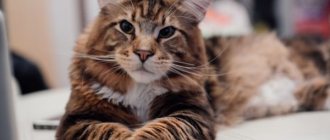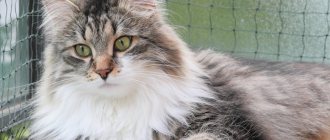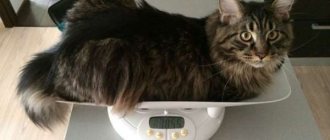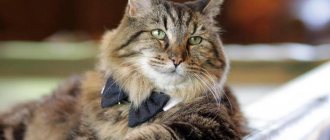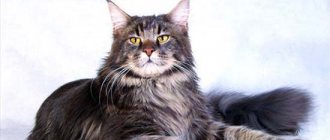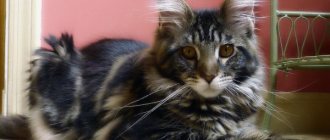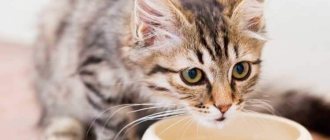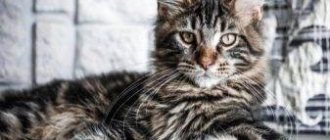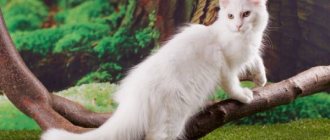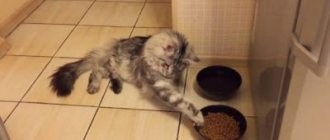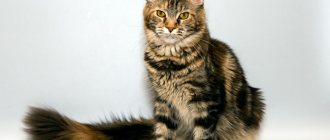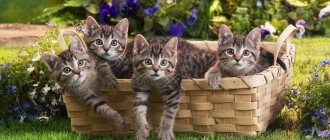The serious look of the Manx raccoon cat has always aroused a wary attitude among people. Even when the animal became a pet, and felinologists thoroughly studied its habits, many consider the character of the Maine Coon to be as harsh as its appearance.
The breed's phenotype is so strong that even a Maine Coon mestizo necessarily submits to its influence and carries the main breeding characteristics: large size, unusual coat and love of water.
History of cats and their breeds
Cats and cats are creatures of nature, and their preferences are natural. To procreate, they choose a couple based on certain criteria, where strength, endurance and health come first, and only then external data. The domestication of cats began about ten thousand years ago, and at that time all cats did not have a specific breed, but living in different areas, they differed in appearance and character.
As cats from different areas spread throughout the world, they crossed with each other and the first mestizos appeared, which, in turn, continued to reproduce. This is how modern cats appeared, which differed in physique, length and color of fur, and character. With the development of progress, the study of genetics began and the identification of the causes of differences in the color and character of pets began, as well as their unification into separate groups - breeds.
- Some arose naturally without human intervention, such as the Siamese cat. Others are bred artificially, through long-term crossings of different species. One of the representatives is British. In fact, this is a mixed-breed cat whose parents were English and Persian domestic cats. For still others, the main distinguishing feature of the breed is caused by a gene mutation, for example, in Scottish cats it is folded ears. Subsequent work was aimed at preserving such features.
Today there are more than 400 cat breeds.
Maine Coon: a mix of who with whom and how the breed began
Scientists have already proven that all modern cats come from the Fertile Crescent. In our time, this is the space from Egypt and Israel, through Turkey, to the ridges of the North Caucasus.
Together with warriors and merchants, cats traveled on ships, where there were always supplies of food and, of course, rodents that were attracted to food. So the close existence of man and cat was mutually beneficial for both parties.
The Maine Coon's ancestry is not associated with the Middle East. It is believed that the blood of Maine raccoons flows in his veins, which gave the cat its second name. The Maine Coon has lived alongside humans for a century and a half and is considered a native breed to its geographic region.
At the turn of the 19th and 20th centuries, Maine Coons lost popularity due to the fluffy Persian cats that were brought by European emigrants. The raccoon cat breed was saved by farmers. Pampered Middle Eastern aristocrats were unable to fight rodents, and the Maine Coon's hunting skills made it an indispensable household assistant.
The Maine Coon population has been preserved in its original form due to the fact that felinologists did not seek to dilute the native blood by crossing the giant cat with other breeds.
In 2002, the General Assembly of the World Cat Federation allowed official interbreed matings of Maine Coons with Siberian and Norwegian forest cats, as well as with Turkish Angora.
These representatives are in no way inferior to the authority of the big American cat in terms of phenotypic stability, immunity and antiquity of the genus. Half-breeds of these breeds are capable of improving the performance of the cat family and developing them in the planned direction.
Mixed cats
Despite the fact that kittens from representatives of various breeds can be bright, graceful and funny, mixed breeds will never become the owners of a pedigree and will not take first places at exhibitions.
Mixed-breed cat - what is it? The answer to this question is known to every breeder, who mercilessly cull kittens born from different breeds. But many modern breeds appeared through random crossing. This is how the Broomilla breed arose from a Persian father and a Bruma mother. The first offspring was not considered a breed, but thanks to the work of the breeder, who continued to work on improving the new species, the Broomilla was recognized and included in the International Register of Pedigree Cats.
Métis British
Mixed breed cats have always existed, and the British are no exception. The history of their origin began with the islands of Britain, where imported Persians were crossed with local representatives - English domestic cats. The new breed was called British. She combined English intelligence and Persian proud stubbornness.
To obtain new colors, breeders crossed this breed with their relatives, the Persians. As a result of their labors, a mixed breed of British and Persian was born. The breeding of such mestizos continued until 2003, after which it was prohibited due to signs of degeneracy in both breeds. Today, a kitten from a Persian cat and a British cat is characterized as outbred and does not receive places at exhibitions.
Also relevant were the matings of British and Scottish shorthair cats, which were used to breed Scottish Folds or Scottish Folds. Since lop ears are caused by a mutating gene, mating of two mutants is prohibited due to the risk of hereditary diseases and skeletal deformities incompatible with life in the offspring.
The result of mating a Maine Coon and a regular cat
The cat and the Maine Coon cat were bred naturally and all efforts of the breeders are aimed at preserving their character traits:
- friendliness; poise; agreeableness; caution; lack of aggression; loyalty.
A Maine Coon mixed breed, obtained as a result of mating a representative of the breed with an ordinary cat, loses its characteristic features or they are distorted. The color of the coat will not change much, because most outbred cats have a color similar to the Maine Coon, but genetic traits of their ancestors may appear. Eye color will depend on the dominant color of the father or mother.
Maine Coons have medium-length hair, and if the partner was smooth-haired, then the kittens will be born with short hair.
Character, weight and body structure are difficult to calculate. A Maine Coon mixed breed can combine the traits of both parents and have different characteristics. Kittens are more massive than outbred cats, but inferior in size to purebred cats, the same applies to their character: some are affectionate, others are more aggressive.
Interesting facts about the Siberian cat breed
At the end of the 20th century, the current standard was approved, which distinguishes one breed from another. Existing canons of breed interpretation include taking into account the following factors:
- the weight of an elite representative of the species;
- height at withers;
- head shape;
- eye color and shape;
- tail;
- wool;
- general appearance of the physique.
Thai cats and their differences from mixed breeds
At the turn of the 19th and 20th centuries, Siamese cats appeared in England, but people noticed that they differed from each other in body structure and divided the breed into two types:
- cats with a strong build and rounded heads are the ancestors of today's Thais; graceful with an elongated muzzle - Siamese.
The Thais interested scientists and work began to improve the breed. As a result of the work, today there are three types of Thais: classical, traditional and modern.
Purebred Thai cats should have a large round head with a high forehead and a convex, powerful sternum. Almond-shaped eyes and set ears prove that the breed came from the East. Thanks to numerous crossings, the standard color of the Thais was diluted with cream, red, tortoiseshell and tabby (brindle).
By nature, these are loyal, balanced cats with high intellectual abilities, very sociable and able to change intonation.
A mixed-breed Thai cat, after crossing with a barn cat, has a pronounced external resemblance to the breed, but is fundamentally different in character due to its unbalanced psyche. Such mestizos can be aggressive and angry. This is due to the instinct of a hunter who is forced to defend his territory in the street.
If a mestizo comes from different breeds, then the traits of both parents will be visible in the character and appearance.
British blue
British blue cats are distinguished by their thoroughness. It is reflected in everything: in a powerful body and strong legs, a large round forehead head, a strong pipe tail and, of course, in character!
This breed is called the “businessman’s cat” - and all because they tolerate loneliness quite easily. And when the tired owner comes home, they, of course, are glad to see him, but they don’t immediately climb on their knees, but are ready to just sit next to him and listen to the story about how the day went...
Orange-eyed Brits don't really like being turned into toys, so they may not be the best choice for a large family. On the other hand, they are non-aggressive, clean and intelligent.
Of course: after all, their pedigree dates back to the first scientific works of Carl Linnaeus! True, at that time these cats were considered French - the main hypothesis of their origin says that this unusual breed was bred by Carthusian monks in a monastery in the vicinity of Paris.
Metis or mongrel?
True purebred cats are significantly inferior in number to outbred and mestizo cats, the difference between which lies not only in color, but also in behavior and health. As a result of family ties that were carried out for improvement, purebred cats have numerous mutations and a number of congenital pathologies. Mestizos and outbreds are distinguished by stronger physical characteristics and immunity.
Outbred cats often have short hair, which helps with hygiene. The most common color is brindle, but tortoiseshell, blue, spotted and solid are also found. According to their external characteristics, yard cats can be divided into northern and southern types. Those living in the north are distinguished by thicker, lighter hair and stocky, large physiques, while those living in the south are darker, smoother and more graceful.
A mixed-breed cat is also a mongrel cat, but has the characteristic features of purebred cats. This is manifested in color and physique, character and health. Mixed breeds have a chance to get the breed. To do this, the owners need to breed offspring from a mixed-breed parent couple (not father and mother, but of the same breeds) and cross the offspring with each other. And only the fifth generation can become a contender for thoroughbred.
Breed standards Siberian cat
According to the standard descriptions of the Siberian cat, its data should be as follows:
- The body weight of an adult animal should reach ten kg.
- Height at the withers is forty centimeters for a male, ten centimeters less for a cat.
- The head is large. It allows the presence of tufts on the ears, which gives the Siberian a resemblance to its wild relative – the lynx.
- The eyes are oval, slightly slanted, and the color is either greenish or yellow.
- Fluffy and moderately long tail.
- A purebred cat must have two undercoats and an outer coat that is impermeable to water. In summer, Siberians look like short-haired breeds; only the tail remains fluffy. With the onset of cold weather, a cute collar appears, and the hind legs are decorated with fluffy “pants.” Well, the tail fluffs up even more.
What are the good things about mestizos?
Despite the fact that mestizos cannot become winners of exhibitions, such cats can be kept as a faithful companion. They will delight you with their company and will not cause much trouble, because, unlike their purebred counterparts, mestizos are different:
Health. Having a stronger immune system, the mestizo gets sick less often. Intelligence - much easier to train and get used to the tray. Unpretentiousness in food.
The character of a mestizo is formed from the characteristics of the breeds of his parents. Both maternal and paternal qualities or both may predominate in it. In terms of skeletal structure and aesthetic characteristics, a mixed-breed cat may be superior to its parents, but it will never become an exhibition winner.
How to choose the right kitten
In order not to make a mistake when choosing a pet, it is not enough to listen only to your inner instinct. Experts advise following the basic rules:
Ask the breeder about all the offspring to determine whether the kittens are suitable: where they grew up, what their character is, whether they were examined by a veterinarian, whether the kittens were picked up after two weeks of age. Have any preventive treatments and vaccinations been carried out? First look at mom. If the kittens are from a nursery, then you should find out as much as possible about the parents. You should not take obstinate representatives who hiss and scratch.
A healthy animal can be identified by the following signs:
- clear eyes without discharge; clean area under the tail; shine of wool; absence of bloating - the first sign of helminthiasis; energy and curiosity; communication with brothers; fearlessness.
Any kitten - purebred, mestizo or mongrel - can become the best friend and companion. He will reciprocate the sincere love and care of the owner. You should not chase expensive, fashionable and purebred cats; it is better to bring into your home a faithful and devoted companion who will not leave you in difficult times and will brighten up the melancholy of gray everyday life.
Interesting features of the Siberian cat breed
- The first mention of Siberian cats dates back to the 16th century. But then they were called Bukhara cats.
- Representatives of this breed are excellent hunters. Having a Siberian cat in the house, you can forget about the existence of any rodents.
- Cats are wonderful fathers and help their “wives” raise their children.
- They are distinguished by monogamous relationships. Cats enter into a “love” relationship with only one cat.
- Siberians are independent and independent creatures. These kinds of pets are suitable for people who do not have the opportunity to devote a lot of time to their pets. Without its owners, the cat will not be bored, but will find something to do to its liking.
- Tortoiseshell males, as a rule, do not give birth to offspring.
- Siberian cats get along well with small children and dogs.
- They recognize only one owner; the rest of the household, at best, are considered only their equals.
- They love boiled shrimp and for the sake of this delicacy they can resort to “blackmail”, refusing to eat other foods.
Diseases of British cats
British cats are a naturally bred breed, so they are naturally quite hardy and healthy.
Naturally, like all other cat breeds, they have “their” specific diseases.
The most serious problem is considered to be the existence of both blood types (A and B), but this can only interfere with the planning of offspring.
They are relatively healthy at birth, but quickly die within 3 days . The reason for this is antibodies developed by the cat against another type of blood in the cat.
They are passed through the mother's first milk, attacking and destroying the kittens' red blood cells.
Now there is a special DNA test that is carried out on British people at an early age, so the problem can be avoided. True, this is only possible for American breeders for now.
A disease such as
Hypertrophic Cardiomyopathy (HCM) , observed in British cats (as well as Persians, Ragdolls, Orientals and Bombay cats), is also genetically determined.
It manifests itself most often in adult animals, therefore, at the age of 1 year, it is necessary to give the animal an ultrasound of the heart , repeating it every 2 years.
If by the age of 8 the disease has not been detected, then you can safely consider your pet healthy in this regard. Unfortunately, this disease cannot be treated.
The heredity of the disease can be autosomal dominant or pedigree.
From the age of 5 months, British children need to
carry out mandatory prevention of worms and other parasites such as hypodermic mites, ear mites and fungus (cat lichen).
Deworming is contraindicated in weakened, pregnant and lactating cats.
Diarrhea in Britons can also have several causes.
The most common is unhealthy diet: only meat or milk, spoiled foods that are difficult to digest.
It is also caused by the presence of intestinal worms, motion sickness when driving a car or on a train, fear or excitement, and the appearance of a new animal in the house.
Before taking action to rid an animal of diarrhea, you need to correctly determine the factor of its occurrence. Self-medication, again, is strictly contraindicated!
Hair loss in British cats can be associated not only with periodic shedding (2 times a year) and childbirth, but also with such problems as:
- worms; diseases of the pancreas, liver; disruption of the gastrointestinal tract; constant stress; avitaminosis; poor nutrition; weak immunity; dermatitis, fungus.
Like all cats, the British often and with pleasure lick their fur, but due to the thicker and more powerful undercoat, it enters the stomach in large quantities and rolls up into clumps there.
This can lead to serious esophageal upset or blockage and even become an indication for surgery, especially for Highlanders.
You can avoid trouble if you give adult cats specially developed drugs that normalize digestion and dissolve hair.
Naturally, preliminary consultation with a veterinarian is necessary.
British cats require periodic (usually weekly) eye rubbing to remove dark deposits and discharge.
Cotton pads that are moistened with boiled water are suitable.
Britons can get watery eyes . There are also several reasons for this:
- some worms, the early stage of development of which takes place in the lacrimal sac;
In these cases, immediate medical consultation and assistance is necessary.
Another scourge of the British is
claw fungus .
To identify lesions in the early stages, the claws are systematically examined.
If they are healthy, they will be powerful, even, and have a uniform structure. There are no stains or various deformations.
Nails need to be trimmed once a month and be sure to have a scratching post.
Healthy eyes and claws, by the way, are important criteria for choosing a British kitten.
British cats don't usually get tooth decay, but like most short-faced breeds they do get
tartar , which causes gums to bleed and teeth to fall out.
Therefore, constant oral hygiene is necessary.
A complete change of teeth in British kittens occurs by 6 months.
A healthy oral cavity means that your teeth will be white and your gums will be pink.
Eating occurs without difficulty, there is no bad breath and excessive salivation.
If tartar has already appeared , then only a specialist can remove it using special equipment, followed by the use of the necessary medications.
Britons are often prone to obesity .
To prevent it, you need to carefully plan your cat's diet (with the help of a veterinarian) and force your pet to be physically active.
Beginning lovers of British cats are concerned about the issue of sagging belly in an older pet.
This is normal for all British cats and cat breeds bred on their basis (Scottish, for example); and is not considered an exterior flaw.
Only cats lose their belly while feeding their babies, then it appears again. It becomes noticeable in kittens from 5 months of age.
British kittens and young individuals up to one and a half years old are very sensitive to various infectious and viral diseases.
Since the baby receives the necessary antibodies from the cat’s mother’s milk to develop short-term immunity, the mother must be vaccinated.
itself needs to start getting vaccinations shortly before the mother's immunity expires, i.e. no later than 2.5 months.
British kittens are vaccinated against:
- respiratory tract infections; ringworm; feline panleukopenia; rabies (this vaccination is also recommended for adult cats).
These recommendations for maintaining good health and strong immunity in British cats are quite simple and essentially boil down to proper feeding, timely deworming and vaccinations, and periodic preventive medical examinations.
Conditions for keeping the Siberian cat
Maintaining a furry creature will not require much effort or time. Siberian purrs quickly get used to the tray and are neat and clean. Since cats have rather hard hair, it does not form tangles and does not need frequent brushing. It is enough to brush your fluffy beauty once a week. True, during the spring and autumn molting period the procedure will have to be carried out more often.
The Siberian cat does not like water and should be washed only after a walk in nature. During the water procedure, it is necessary to tightly close the ears with cotton wool, and the water temperature should be in the range of 38-39 degrees.
Considering the strength of Siberians, it is better to wash a cat together. After the “bath”, you need to thoroughly wipe your pet and let it dry in a warm room where there are no drafts.
Important! Regular cleaning of the ears is necessary, and the corners of the eyes should be wiped with a damp cotton swab.
Rules for breeding cats of the British breed
The mating rules for British cats are slightly different from the mating rules for other breeds. This is due to the fact that the British are quite large: a cat at six months catches up with a one-year-old cat at the withers, becoming the same size as it. But at the same time, he is not yet ready to mate. Large size is not an indicator of a mature skeleton - one must wait until puberty so as not to risk the health of the animal.
Puberty in the British occurs at 7-9 months. But it is better to breed a cat with a cat in the period from 10 months to one and a half years, when she is strong enough and can give birth without risking her health.
You need to skip the first two heats, and take the cat to the “groom” on the third. If your pet shows increased sexual activity and the estrus risks developing into a protracted one, you can breed a cat with a male at the age of 10 months. A cat at the age of two years finds it more difficult to make contact with a cat and becomes aggressive.
A British cat's behavior is changing. She prefers communication with the strong half of humanity. Ignoring the hostess, she fawns over the men in the house and runs to greet the male guests. She rubs against their shoes, plays with their socks and begs for affection. The main features in the changed cat behavior:
- the animal becomes more affectionate; requires attention all the time; arches its back, moves its tail to the side; moves with bent hind legs; the lower body and tail tremble slightly; the cat begins to frequently lick itself under its tail; Meows loudly under the door and at night.
These are obvious signs of the onset of estrus, which are quite difficult not to notice. Usually the first heat does not bother the cat and its owners much. The animal has not yet realized what the body requires, and most often behaves calmly. The intervals are different for everyone, usually 15-20 days pass between heats, and they last 7-9 days. Under no circumstances should you give your cat drugs that suppress and interrupt estrus: this leads to hormonal imbalances and the development of tumors.
After making sure that the cat is ready for mating, you need to arrange a meeting for her with a pre-selected “groom”. Usually it is the cat that is taken to the cat, and not vice versa. estrus . For the first time, it should be an experienced cat who can cope even with the obstinate character of a young impatience. Since the pet will be visiting for more than one day, she will need her things:
1. A tray for the cat to go to the toilet that preserves its smell. 2. Tray filler. 3. Bowls for water and food. 4. Food to which the animal is accustomed (calculating the supply for three days). You can bring gifts to the “groom”, after finding out what he likes. 5. A carrier in which the cat can rest when she gets tired of her annoying boyfriend.
You need to get your pet in order in advance: trim its claws and clean its ears. A few days before the intended mating, carry out anti-flea treatment, give an anti-helminth tablet (14 days before) and drip the ears with anti-tick drops. Immediately before mating, you cannot treat a British cat with any drugs, as their smell will scare the cat away.
The cat must be vaccinated against diseases such as:
- rabies; lichen; rhinotracheitis; chlamydia; calicivirus infection; panleukopenia.
One vaccination includes a complex composition and with a couple of injections protects against all diseases. The passport with vaccinations is brought along with the cat. You will also need a copy of the pedigree (if available). It is not recommended to bathe your pet so as not to destroy the scent that is attractive to the male.
For mating, it is better to choose a cat that matches the color of its coat. Of all the variety of colors, classic blue remains the most popular. This color is usually combined with orange eyes. There are also such colors: black, white, cream, lilac, chocolate, red. Less common are cinnamon (cinnamon) and tortoiseshell colors. Whiskas (a gray fur coat with small spots) and chinchilla are also popular. There are two types: white and golden chinchilla with amazing green eyes.
It is important to take into account the colors of the animals and not to breed, for example, a black cat with a purple cat, so that the kittens do not turn out to be multi-colored. Although this will not affect the health of the offspring, animals of a single color are more suitable for exhibitions and sales.
The coat of a British cat should be thick, short and soft to the touch, and the color should be uniform, without white hair, spots or streaks (unless this is specified by the color).
For the first 24 hours, the British woman may not let the cat near her. This is normal, so there is no need to force her towards it or immediately take her out of the carrier. Usually animals go through the familiarization stage on their own.
When the female yields to persuasion, 15 or more matings occur per day, depending on the cat’s temperament. After two days, the “groom” gets tired and loses interest because the cat’s smell changes, although she may still flirt with him and not calm down. At this time, you can already take her home, because two days of mating is quite enough for pregnancy.
It is not recommended to breed a cat more than three times a year. This will weaken her, and she will give birth to sick offspring.
At home, the British Shorthair cat does not calm down for some time, but this does not mean that she is not pregnant. If the cat comes into heat after three weeks, it means the cat is not pregnant. In this case, she is again taken to a “date” and again they begin to count 65-68 days from the first day of mating.
A young cat needs to choose an already experienced cat who understands well why she was brought. According to the rules of mating, it is not recommended to mate two inexperienced animals. The cat may turn out to be both overly persistent and inept, and the cat will begin to fall on its side. The owner will have to help them, and this will take more time.
Gradually calming down, the cat sleeps more. In the third week, the appetite disappears and the pet becomes nauseous. In the second half of pregnancy, the appetite increases, and the British woman sleeps almost all the time. From the 21st day, her nipples become enlarged, becoming dark red in color, and her belly becomes noticeable.
Two weeks before giving birth, the expectant mother is looking for a new place. She is already preparing for the upcoming event and selects a secluded corner. This could be a desk drawer, shelves, closet, bedside table or any other place. The cat throws out things it thinks are unnecessary and makes a “nest.” At this time, you can offer the cat a comfortable box or house. Soon she herself will understand that the prepared place is comfortable and warm, and she will calm down.
You need to prepare for childbirth in advance and purchase everything you need. The advice of a veterinarian and experienced breeders will help with this. You will also need to agree with the veterinarian about urgent treatment if the cat has a difficult birth.
Color of the Siberian cat breed
The photo of Siberian cats shows how different colors breeders do not tempt potential buyers! Among the most popular we note the following:
- tricolor;
- ginger;
- brick;
- golden and silver;
- tortoiseshell;
- two-color;
- the coat has a blue tint, and the nose and paws are gray.
There are several other colors, for example, the gray Siberian cat and the Neva masquerade, but the federation of cat lovers has not yet approved them as a standard.
The color of a kitten's coat is determined by the influence of parental melanin. In nature, there are two types of this substance - black and red. The interaction of colors is the basis for the formation of all existing colors. The exception is the white color of animals.
And a little about secrets.
The story of one of our readers, Irina Volodina:
I was especially distressed by my eyes, which were surrounded by large wrinkles, plus dark circles and puffiness. How to completely remove wrinkles and bags under the eyes? How to deal with swelling and redness? But nothing ages or rejuvenates a person more than his eyes.
But how to rejuvenate them? Plastic surgery? I found out - no less than 5 thousand dollars. Hardware procedures - photorejuvenation, gas-liquid peeling, radio lifting, laser facelift? A little more affordable - the course costs 1.5-2 thousand dollars. And when will you find time for all this? And it's still expensive. Especially now. Therefore, I chose a different method for myself.
General concepts
A mixed breed is a cat from parents of different breeds or without one at all.
In principle, any kitten without documents is called this all over the world. This does not make him worse or better, but the breed cannot be recognized in him. There are conditions that by the exterior at the exhibition you can determine whether you belong to the coon phenotype. There are two main definitions - genotype and phenotype. The first is “internal content,” the set of genes that was passed on from parents. From each of them, kittens receive half a set. Phenotype – external characteristics. It is also passed down from ancestors and depends on combinations of genes. Color, length of the body, limbs, shape of the skull are inherited, like other parameters, but assumptions about the appearance of the future offspring are usually not justified. You can delve into the laws of genetics and calculate what color kittens will be born. Character and temperament will remain a secret until the individual fully matures.
The breed was bred naturally. Breeders cultivate those qualities that are characteristic of the Coon:
Friendliness; Equilibrium; Flexibility; Caution; Lack of aggression; Loyalty.
When mating with an ordinary representative of the cat family, these features are transformed and sometimes disappear altogether. According to the rules, a real Maine Coon is considered purebred if its ancestors are known in 4 generations. That is, he must have a pedigree with the specified parents, etc.
Possible offspring
No significant changes are expected in terms of coat color. Most domestic cats without admixture from other breeds have the colors acceptable in Maine Coon Cats. But genetics suggests unexpected results. Mutations, such as polydactyly, which is common in coons, are likely to affect part of the litter. Coat color and pattern are inherited according to established laws.
Science knows interesting facts about eye color. Usually it does not depend on the color of the coat, but blue pigment accompanies color-point colors (Siamese cats), and less often white. In practice, if you cross a green-eyed coon with a blue-eyed female, the offspring will most likely take after the father for this trait. This happens because green is dominant to blue. When white kittens are born, the situation may change.
All Maine Coon cats have medium-length fur. If you cross a representative with a smooth cat, the litter will be short-haired. The birth of kittens with long hair is possible if there are two long-haired parents.
Character and behavior are unpredictable in this combination. Street cats are more aggressive by nature, this is dictated by the laws of survival in difficult conditions. Pedigree cats are softer, because purposeful work has been carried out for decades to consolidate behavior that is comfortable for humans.
Weight and body structure are also difficult to calculate, but most half-breeds are distinguished by their impressive dimensions, although they are inferior to their purebred parents. Kittens are born with different characteristics, some are smaller, some are larger.
Metis requires the same careful attention as a purebred animal. A balanced diet, walks, and the love of the owner are mandatory criteria for the happiness of any pet.
Russian blue
A favorite of the ancient Slavs. The Russian Blue can be considered a model of a domestic cat: even Peter I kept just such a Vaska, and Catherine II gave blue kittens to foreign ambassadors. Later, in the 19th century, this breed moved to Europe in a more democratic way - with the help of English sailors who visited Arkhangelsk.
They were shocked: they had already encountered an unusual coat color among their native “British” cats (this breed will be discussed below), but Russian cats were much slimmer, had an elegant narrow muzzle and almond-shaped green eyes.
With the light hand of sailors, the breed began to be called “Arkhangelsk”. And only in 1893, when the Englishwoman Karen Cox specially went to the Primorsky Territory to buy kittens and became the first official breeder, the Russian blue cat became known to the world.
In their native country, there was little interest in the breed until the 80s of the last century, and almost all of the “new Russian blue” cats came from abroad. But now we can say that our felinologists did their best! Russian beauties have a good character: they are very attached to their owner, they love to “hugging” with their paws without releasing their claws.
Problems and breeding
A decent breeder will never approve of the meaningful mating of a coon and an outbred female. This often leads to the following consequences:
A cat may die in childbirth if the kittens are very large; The purity of the breed is lost; You cannot conduct breeding activities with a half-breed; Unpredictable animals in terms of mental health and health.
As a rule, mestizos are sold at low prices. They are of no interest and lose value for breeding. The work of the breeder is highly appreciated. The price for a purebred kitten cannot be below a certain level.
Differences between a coon and a purebred kitten:
Large sizes; Recognizable muzzle profile; Large ears, possibly with a tassel; Semi-long topcoat; A long tail; Strong bones; Wide chest.
Usually a cross between Coons and nobles looks simpler. Even purebred animals with minor defects or weak types are sterilized to prevent them from producing offspring. Sometimes even experienced people have unforeseen circumstances when a Maine Coon mates with a noblewoman. Even in this situation, animals are given away free of charge or for a symbolic amount, with the condition of mandatory sterilization in the future.
Before buying a coon, you should look at his parents, find out their origins and study pedigrees. The breeder always hands over the documents (metrics) of his graduates. Otherwise, there is a risk of acquiring an outbred animal. Kittens move to a new home no earlier than 3 months, after vaccinations and other necessary procedures. Mestizos are usually given away earlier due to the high costs of raising them.
In the recent past, there have already been attempts to register non-purebred coons. Several breeds were used to breed them:
A similar situation is observed in the dog world, but there designer breeds have become successful due to their cute appearance and clever advertising. Both types of kuna hybrids have remained unrecognized by the felinological community. The work did not live up to the hopes of the breeders. The resulting kittens turned out to be of different types, without the desired characteristics.
Problems also arise when cat owners realize they don't have a coon. Many raised animals end up in shelters or worse, on the street. Growing up at home, they cannot withstand the difficulties they encounter on their own. In addition, uncontrolled reproduction begins, and the number of street children is rapidly increasing. They are susceptible to infections, their immunity is weakened, and the infection spreads further.
How to buy a British cat?
Just a few tips for future British Shorthair owners. First, decide why you need a pet of the British breed:
- Do you want a cute home “bear cub”, a decoration for a sofa cushion, or are you planning a dizzying career or exhibition?
- Will you “continue the lineage” of your pet or is there no need for you to take care of kittens?
- Are you ready to raise a kitten from a very young age or do you not have the energy and time for this?
If you have no ambitious plans and you are happy with a pet, but are not interested in breeding, it is quite enough to purchase a “pet”. Responsible breeders will sterilize such kittens immediately, so there will be no problems with the cat’s heat – screaming at night, tattered corners – there will be no problems. And the cat will be calmer and will not mark doors and upholstered furniture.
Many nursery owners are happy to hand over “pensioners” to good hands for a purely nominal fee or even for nothing. These are animals that, due to age or other reasons, no longer participate in the breeding program. Don’t be alarmed by the word “senior” – such a cat may be only 6-8 years old. And she still has a long, happy life ahead of her. In addition, an adult cat will cause virtually no trouble to the new owner. But they get used to their new home quite quickly. Literally a week or two - and you will not imagine how you ever lived without a cat.
You should only carefully approach the choice of a pet for exhibitions - this is a potential show class. If the question is fundamental, then it is better to look at the grown-up kittens - here all the characteristics of the future champion are better visible. And be sure to travel to exhibitions, track the growth of kittens in different lines using photos and videos. They approach the choice of a pet for breeding in a similar way, only here pedigree comes to the fore. It would be a good idea to consult with several specialists and complete felinological courses.
Participation in exhibitions, documents
This American cat breed was formed many years ago. The task of breeders is to preserve and improve the gene pool. The participation of a simple cat in breeding negates their efforts.
Due to such factors, owners of hybrids cannot exhibit their pets in the breed ring. However, exhibitions where animals of unknown origin are judged are open to them. There they can show the pet and get a description if the cat is healthy, has a beautiful exterior, and an easy-going character. When the kittens grow up, it will become clear how large they will grow and what their show potential will be.
They are allowed into the ring upon reaching 10 months of age. The rules are the same as at regular exhibitions. Separate rings, strict judging. A mongrel pet is prepared with full responsibility: grooming, purchasing accessories. This is a great chance to show your favorite cats to specialists and get a lot of positive emotions from communicating with like-minded people.
Outbred cats are not registered anywhere. They cannot have a pedigree, only a veterinary passport with notes on vaccinations and treatment against worms, which the owner obtains at his own request. Subsequent mating with a coon will still result in his phenotype, and not a true Maine cat.
Nutrition of the Siberian cat
Cats are not picky when it comes to food, but having an excellent appetite and knowing the weaknesses of their owners, they abuse this and beg from them for various delicacies.
Recommended diet:
- raw lean beef (need to be doused with boiling water);
- poultry meat;
- boiled sea fish;
- dairy products (cottage cheese, cheese, fermented baked milk).
Kittens, nursing mothers and cats expecting offspring benefit from low-fat cream and goat's milk.
As supplements, you can give boiled egg yolk and a minimum amount of dry food of the highest quality.
Many cat lovers accustom their pets to rice, buckwheat and oatmeal porridge.
Care, maintenance, nuances
According to many people, the mestizo is unpretentious in food and does not require veterinary care.
This is a misconception that is completely wrong. These animals are fed no worse than purebred representatives. Their internal structure of the body is no different. Food must contain all the necessary microelements, vitamins, sufficient amounts of proteins and carbohydrates. If their health fails, then they need to go to the clinic. The legends about the strong immunity that kittens receive from parents of different origins are impressive until the first illness. They suffer from allergic reactions, the effects of poisons from parasites (fleas, worms, ticks), problems with joints and digestion.
From birth they carefully monitor their character. The temperament of such babies can be completely unpredictable.
